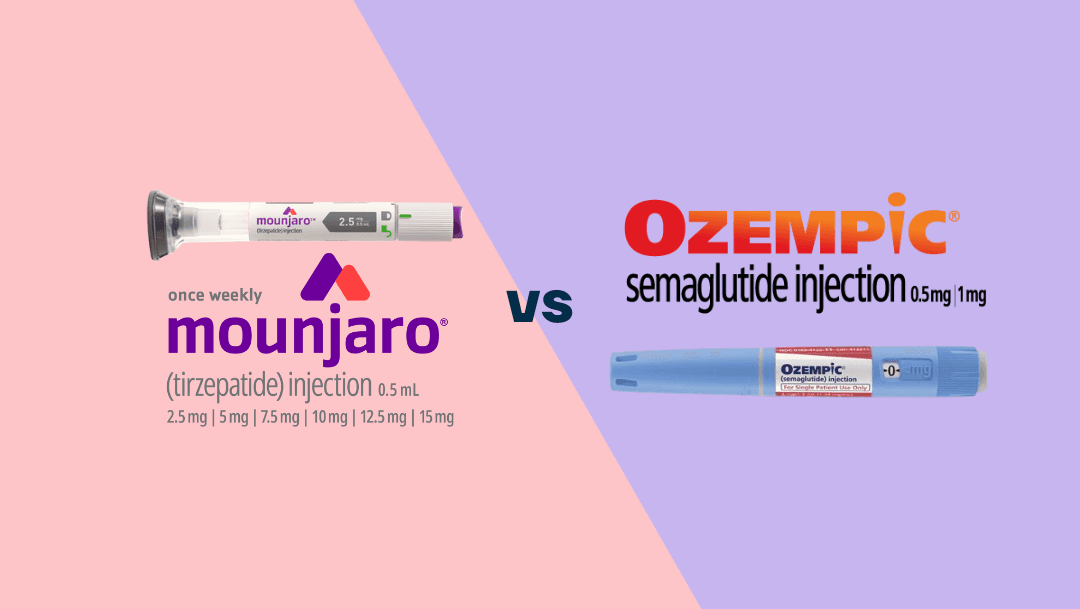Jump to: How do Mounjaro and Ozempic work? | Clinical effectiveness | Making your choice | Take home message
Mounjaro leads to significantly greater weight loss compared to Ozempic (21.4% vs 11.2% body weight reduction at 40 weeks), based on a randomised controlled trial of 1,897 patients.
However, this enhanced effectiveness comes with a slightly higher rate of side effects because the dose in Mounjaro is higher than in Ozempic.
Both medications work by mimicking natural hormones that help regulate hunger and blood sugar levels.
However, Mounjaro’s dual-action targeting two hormones, GLP-1 and GIP, contributes to its increased effectiveness for weight loss.
The drug in Mounjaro is tirzepatide, while it’s semaglutide in Ozempic.
2025 UK Treatment Overview
| Mounjaro: |
£230-£300 monthly (private), dual hormone action |
| Ozempic: |
£300 monthly (private), single hormone action |
| NHS access: |
Ozempic for type 2 diabetes, Mounjaro for weight loss and type 2 diabetes |
How do Mounjaro and Ozempic work?
When we eat food, our body releases several hormones that help regulate hunger and blood sugar levels. One of these crucial hormones is GLP-1 (glucagon-like peptide-1), which plays a vital role in metabolism and appetite control.
GLP-1 works in multiple ways to support weight loss. It improves insulin function, helping to lower blood sugar levels, while also slowing down the rate at which food leaves our stomach, helping us feel fuller for longer.
Additionally, GLP-1 communicates directly with our brain’s appetite control centre, the hypothalamus, reducing food-seeking behaviours
However, the GLP-1 we produce in the body has a significant limitation: it’s quickly broken down by an enzyme called DPP-4, with up to 50% being removed by the body in under 2 minutes.
Mounjaro and Ozempic have been specifically designed to avoid this breakdown, allowing them to remain active in the body much longer.
What sets Mounjaro apart is its additional function. Beyond mimicking GLP-1, it also mimics the hormone GIP (glucose-dependent insulinotropic polypeptide).
This dual action contributes to its enhanced effectiveness in supporting weight loss.
Do you lose more weight on Ozempic or Mounjaro?
Clinical research demonstrates significant differences in effectiveness between these medications.
A comprehensive study involving 1,897 individuals revealed that Mounjaro leads to more substantial weight loss compared to Ozempic after 40 weeks of treatment.
Clinical Outcomes Comparison
| Clinical Measure |
Mounjaro (15mg) |
Ozempic (1mg) |
| Average Weight Loss |
21.4% body weight |
11.2% body weight |
| HbA1c Reduction |
2.3% reduction |
1.8% reduction |
| Side Effect Rate |
6-8.5% discontinuation |
4% discontinuation |
These results demonstrate Mounjaro’s enhanced effectiveness, likely due to its dual action.
However, it’s important to note that individual responses to these medications can vary significantly, and what works best for one person may not be optimal for another.
The higher effectiveness of Mounjaro comes with a slightly increased rate of side effects, which should be carefully considered when making your treatment choice.
More patients discontinued Mounjaro in clinical trials due to adverse events compared to Ozempic (6-8.5% vs 4%).
Making your choice
If you’re looking for a weight-loss injection in the UK, you’d only be able to access Mounjaro if you were eligible, as Ozempic is only available as a type 2 diabetes medication.
The drug in Ozempic, semaglutide, is available for weight loss but is sold under the brand name Wegovy.
While Mounjaro typically leads to greater weight loss, Ozempic’s established safety profile and lower side effect rate might make it a more suitable choice for some individuals.
Your healthcare team will consider various factors when recommending either medication, including your medical history, current health status, and treatment goals.
They’ll also take into account any other medications you’re taking and your personal preferences.
Both medications are administered as weekly injections, though the exact dosing schedules may differ. Your healthcare provider will typically start you on a lower dose and gradually increase it based on your response and tolerance.
Mounjaro dosing schedule:

Ozempic dosing schedule:
- Weeks 1-4: 0.25 mg
- Weeks 5-8: 0.5 mg
- Weeks 9+: 0.5 mg (or 1 mg if clinical targets aren’t being met)
Take home message
Weight-loss injections like Mounjaro and Ozempic can be valuable tools to kickstart weight loss and lower blood sugar levels, particularly when combined with sustainable lifestyle changes.
While Mounjaro demonstrates more significant average weight loss, Ozempic offers a well-established safety profile with fewer reported side effects.
Remember that these medications work best when combined with healthy habits, like eating a diet based on whole foods, regular physical activity, and adequate sleep.
They can help create the space needed to develop and maintain healthy habits for long-term success.
Second Nature’s medication programmes
Second Nature offers comprehensive support through our Mounjaro weight-loss programme.
Why choose Second Nature over other providers if you’re eligible?
For peace of mind.
Second Nature has worked with the NHS for over 6 years, providing evidence-based weight-loss programmes across the UK.
While our medication programmes are private, we maintain the same high standards of scientific evidence, patient safety, and data security that have earned us NHS trust since 2017.





